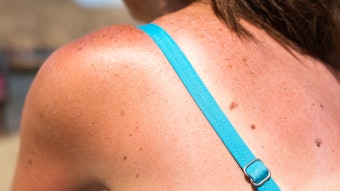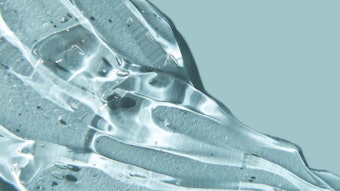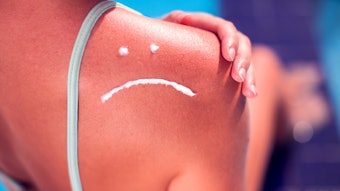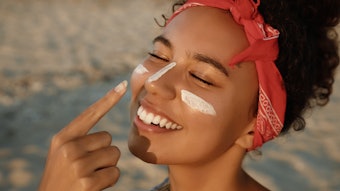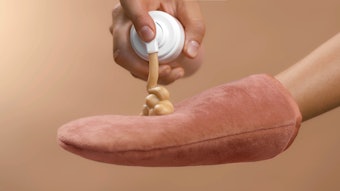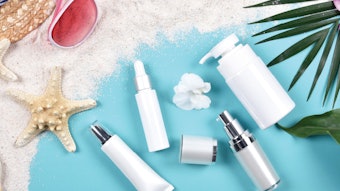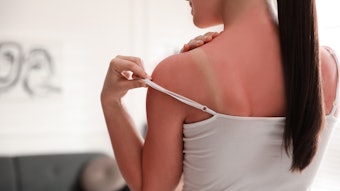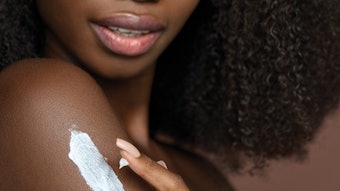
Many consumers have received conflicting messages about sun exposure throughout their lifetimes. For years, having a tanned glow was considered a sign of beauty, health—and even wealth. Sun exposure was something people craved. When I worked as a tennis instructor at a Caribbean resort back in the 1980s, getting a tan was considered an on-the-job bonus! However, in recent years, research has revealed the detrimental health and cosmetic effects of excessive sun exposure.
The dangers of skin cancer need to be taken seriously. As a skin care professional, you are on the front lines of skin safety. By getting an up-close view of the skin, you may see marks on a client that have gone unnoticed. If you identify irregular pigmented marks that look suspicious, refer the client to a medical professional for further examination. However, if your clients have cosmetic concerns about benign sun damage, this is where you can help!
A number of procedures can be used to fade sun spots—also called age spots and solar lentigines. There are also treatments that can help reduce the appearance of wrinkles and soften leathery-looking skin. The following information can help you determine the best service—or combination of services—on a case-by-case basis.
How sun damage occurs
The culprit behind most extrinsic, or externally caused, aging is ultraviolet (UV) radiation from the sun. UV radiation is invisible to the naked eye, but definitely impacts the skin in multiple ways. To understand the full effect of UV radiation, it’s best to break it up into two subcategories: UVA and UVB.
UVA rays are long-wave solar rays that are able to penetrate the skin’s epidermal and dermal layers. They are main cause of sun spots, wrinkles and leathery skin—symptoms that are collectively known as photoaging. UVB rays are primarily responsible for damaging the epidermis and producing a sunburn or reddening effect on the skin. Scientists have long believed that UVB rays play the main role in the development of skin cancer but, in recent years, they have discovered that UVA rays play a significant role, too.
When the sun hits the skin, melanocytes (cells that produce melanin) move to the skin’s surface as a self-defense mechanism. However, it is a myth that getting a tan will protect your skin from further damage. The extra melanin in tanned skin produces an SPF of 2 or 4, which is much lower than the recommended SPF 30. Throughout time, repeated sun exposure can result in hyperpigmentation that causes your clients to feel self-conscious about their skin.
Both UVA and UVB rays cause damage that can lead to fine lines and wrinkles. When the rays penetrate skin, they damage collagen and elastin, forcing the body to fight back by producing a large amount of metalloproteinases. Metalloproteinase is an enzyme that normally helps to produce and repair collagen; however, sometimes the process does not work correctly, and the enzymes wind up degrading the collagen even further. The result of all this action is skin that is not rebuilt correctly, which forms wrinkles.
It’s no surprise that lighter skin tends to show the most visible signs of sun damage. When examining and treating clients, it is important to understand their skin type in order to determine the appropriate procedure and get the best results. The most commonly used tool for this is the Fitzpatrick scale. The Fitzpatrick scale is a skin-typing chart that helps to determine an individual’s sun sensitivity and skin cancer risk. (Editor’s note: For more on the Fitzpatrick scale, see “Global Skin: Climbing Your Client’s Family Tree.”) It is also a helpful guide for working with lasers and other light-based devices. Some treatments, including IPL photofacials, should not be used for clients with darker skin.
Solutions for sun-damaged skin
Although clients can’t turn back the clock to abstain from sun exposure in the past, they can erase some of the cosmetic damage that was done. Professional skin care treatments can help remove the skin’s damaged outer layers to diminish sun spots and encourage the growth of new, healthy collagen to reduce the appearance of fine lines and wrinkles. (See Treatment Protocol for Sun Spots.)
Chemical peels. Chemical peel treatments are a good option for bringing new life to sun-damaged skin. These peels utilize various solutions and strengths for different treatment levels and results. You will need to customize the chemical peel treatment for each client, along with planning a structured treatment regimen. Most light-to-medium peels will require at least six treatments over a three-month period to see the best results.
Chemical peels can vary in strength, ranging from very minor solutions that require little to no downtime, to stronger peels that may require a few days to heal. Some of the most popular light-to-medium peels use alpha hydroxy acids (AHAs), beta hydroxy acids (BHAs) and trichloroacetic (TCA) acids, or a combination of various acids and concentrations.
Intense pulsed light (IPL) photofacial. IPL treatments have become very popular as a tool to erase sun spots and fine lines. An IPL photofacial uses a series of gentle light pulses that target the pigment present in sun spots, as well as other color irregularities. As the light travels through the layers of skin, heat from the light causes damage to the abnormally pigmented areas. This will kick-start the body’s natural healing process. The spot will either become darker and flake off, or it will be naturally absorbed by the body. IPL photofacials also stimulate collagen growth to reduce fine lines.
For the average client, three-to-five IPL photofacial treatments are required for best results, and most clients can be treated as frequently as every three weeks. Throughout the course of the treatment process, clients can expect to see improved skin texture and a smoother, more even complexion.
Fractional laser. For a more aggressive treatment for sun damage, there are fractional laser procedures. A fractional laser treats sun spots, wrinkles and fine lines with the use of a laser beam that is split (fractionated) into thousands of microscopic beams of light energy. The pixilated light penetrates the dermis and generates enough heat to stimulate natural collagen production and new cell growth. In addition to reducing the appearance of sun damage, fractional lasers can also help treat acne scars, stretch marks and melasma.
When skin is treated using a fractionalized approach, the surrounding skin is left intact, which helps speed up the healing process. Most clients will see results after one treatment, but they will need a series of three-to-five treatments for optimal results.
Radiofrequency. Services that harness the power of radiofrequency waves are also very effective for helping remove sun spots, reduce wrinkles and tighten skin. A radiofrequency procedure works by sending heat energy into the dermal layer of the skin to stimulate the production of collagen. Unlike lasers, radiofrequency treatments rely on the absorption of radio waves and not light, which makes these services safe for all skin tones.
Hydroquinone. Hydroquinone is a topical treatment used to lighten skin. It works by inhibiting the production of tyrosinase, which is an enzyme that helps to produce melanin. Depending on whether it is sold over the counter or prescribed by a medical professional, hydroquinone can range between 1–10% concentrations. Anything above 2% requires a prescription.
When used alone, hydroquinone treatments may not show visible results for several weeks. To give your client faster results and improve the effectiveness of this treatment, you can combine hydroquinone with a regimen of chemical peels and/or light-based procedures. Additionally, it is a good idea to alternate between hydroquinone and a nonhydroquinone melanin-inhibitor for best results.
The importance of prevention
Educating clients about the dangers of excessive sun exposure is key. Even with an increased level of skin cancer awareness, some people still refuse to give up their tans. The American Academy of Dermatology studied teens’ attitudes about the sun—59% of teens surveyed thought that in general, people look healthier with a tan.
If your clients don’t want to give up their bronze glow, see if you can convince them to try a sunless tan. Advanced self-tanners and spray tans are easy and accessible, and they can provide great natural-looking results without the dangers of sun exposure. If you have the equipment necessary for spray tanning, offer your client a free tan to show them how well it works. Seeing is believing!
If your clients are willing to protect themselves from the dangers of UV radiation, there are tools they can use in addition to wearing a broad-spectrum sun protectant of SPF 30 or higher. For example, did you know that every day the National Weather Service forecasts the UV index for the following day? The UV index shows how much UV radiation reaches the earth’s surface. A UV index reading of two or lower means that there is low danger for the average person, while an index reading of 11+ means there is an extreme risk. To see the full scale, visit the United States Environmental Protection Agency’s website (www.epa.gov) to see how this chart may help you to help your clients achieve beautiful, clear, healthy-looking skin for years to come.


